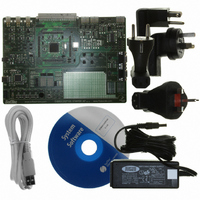EVB9S12XEP100 Freescale Semiconductor, EVB9S12XEP100 Datasheet - Page 137

EVB9S12XEP100
Manufacturer Part Number
EVB9S12XEP100
Description
BOARD EVAL FOR MC9S12XEP100
Manufacturer
Freescale Semiconductor
Type
MCUr
Datasheet
1.EVB9S12XEP100.pdf
(1328 pages)
Specifications of EVB9S12XEP100
Contents
Module and Misc Hardware
Processor To Be Evaluated
MC9S12XEP100
Data Bus Width
16 bit
Interface Type
RS-232
Silicon Manufacturer
Freescale
Core Architecture
S12
Core Sub-architecture
S12
Silicon Core Number
MC9S12
Silicon Family Name
S12XE
Rohs Compliant
Yes
For Use With/related Products
MC9S12XEP100
Lead Free Status / RoHS Status
Lead free / RoHS Compliant
- Current page: 137 of 1328
- Download datasheet (9Mb)
Freescale Semiconductor
DDRM
DDRM
DDRM
DDRM
DDRM
Field
4
3
2
1
0
Port M data direction—
This register controls the data direction of pin 4.
The enabled CAN2, routed CAN0, or routed CAN4 forces the I/O state to be an input. Depending on the configuration
of the enabled routed SPI0 this pin will be forced to be input or output.In those cases the data direction bits will not
change. The DDRM bits revert to controlling the I/O direction of a pin when the associated peripheral module is
disabled.
1 Associated pin is configured as output.
0 Associated pin is configured as input.
Port M data direction—
This register controls the data direction of pin 3.
The enabled CAN1 or routed CAN0 forces the I/O state to be an output. Depending on the configuration of the
enabled routed SPI0 this pin will be forced to be input or output. In those cases the data direction bits will not change.
The DDRM bits revert to controlling the I/O direction of a pin when the associated peripheral module is disabled.
1 Associated pin is configured as output.
0 Associated pin is configured as input.
Port M data direction—
This register controls the data direction of pin 2.
The enabled CAN1 or routed CAN0 forces the I/O state to be an input. Depending on the configuration of the enabled
routed SPI0 this pin will be forced to be input or output.In those cases the data direction bits will not change. The
DDRM bits revert to controlling the I/O direction of a pin when the associated peripheral module is disabled.
1 Associated pin is configured as output.
0 Associated pin is configured as input.
Port M data direction—
This register controls the data direction of pin 1.
The enabled CAN0 forces the I/O state to be an output. In those cases the data direction bits will not change. The
DDRM bits revert to controlling the I/O direction of a pin when the associated peripheral module is disabled.
1 Associated pin is configured as output.
0 Associated pin is configured as input.
Port M data direction—
This register controls the data direction of pin 0.
The enabled CAN0 forces the I/O state to be an input. In those cases the data direction bits will not change. The
DDRM bits revert to controlling the I/O direction of a pin when the associated peripheral module is disabled.
1 Associated pin is configured as output.
0 Associated pin is configured as input.
Due to internal synchronization circuits, it can take up to 2 bus clock cycles
until the correct value is read on PTM or PTIM registers, when changing the
DDRM register.
Table 2-35. DDRM Register Field Descriptions (continued)
MC9S12XE-Family Reference Manual , Rev. 1.23
NOTE
Description
Chapter 2 Port Integration Module (S12XEPIMV1)
137
Related parts for EVB9S12XEP100
Image
Part Number
Description
Manufacturer
Datasheet
Request
R
Part Number:
Description:
Manufacturer:
Freescale Semiconductor, Inc
Datasheet:
Part Number:
Description:
Manufacturer:
Freescale Semiconductor, Inc
Datasheet:
Part Number:
Description:
Manufacturer:
Freescale Semiconductor, Inc
Datasheet:
Part Number:
Description:
Manufacturer:
Freescale Semiconductor, Inc
Datasheet:
Part Number:
Description:
Manufacturer:
Freescale Semiconductor, Inc
Datasheet:
Part Number:
Description:
Manufacturer:
Freescale Semiconductor, Inc
Datasheet:
Part Number:
Description:
Manufacturer:
Freescale Semiconductor, Inc
Datasheet:
Part Number:
Description:
Manufacturer:
Freescale Semiconductor, Inc
Datasheet:
Part Number:
Description:
Manufacturer:
Freescale Semiconductor, Inc
Datasheet:
Part Number:
Description:
Manufacturer:
Freescale Semiconductor, Inc
Datasheet:
Part Number:
Description:
Manufacturer:
Freescale Semiconductor, Inc
Datasheet:
Part Number:
Description:
Manufacturer:
Freescale Semiconductor, Inc
Datasheet:
Part Number:
Description:
Manufacturer:
Freescale Semiconductor, Inc
Datasheet:
Part Number:
Description:
Manufacturer:
Freescale Semiconductor, Inc
Datasheet:
Part Number:
Description:
Manufacturer:
Freescale Semiconductor, Inc
Datasheet:










